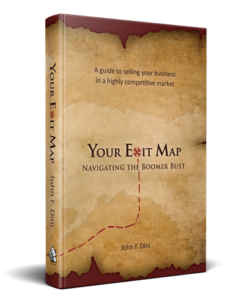Nothing impacts the success of your business transition more than the advisor team. Let’s say you receive a free pass to play in the Super Bowl. You will be playing against the New England Patriots, but you can choose any NFL player not on their roster for your team. Who would you pick?
There are a multitude of opinions about who is the best quarterback, wide receiver or free safety. One thing is pretty certain. You wouldn’t choose the guys you grew up playing touch football with. At least, not if you wanted to win.
Owners feel loyalty to the trusted advisors they already have relationships with. “He’s the attorney who handles all my legal problems,” is a bit like saying “He’s the doctor I always go to when I feel sick.” That is fine, but what if you needed a heart transplant?
Professionals are Specialists
 All physicians went to medical school. In residency, they took rotations in surgery, obstetrics, pediatrics and infectious diseases. That doesn’t mean that twenty years down the road you want someone delivering your newborn child unless he’s practiced it a lot.
All physicians went to medical school. In residency, they took rotations in surgery, obstetrics, pediatrics and infectious diseases. That doesn’t mean that twenty years down the road you want someone delivering your newborn child unless he’s practiced it a lot.
Just as there are many physicians, there are many attorneys and CPAs. They all have some training in all aspects of law or accounting. It is required to pass the bar or to get certified. But if your attorney spent the last twenty years doing real estate closings, or your CPA spends most of his time preparing tax returns, he or she may not be the right advisor for the biggest financial transaction of your life.
Business transitions aren’t simple. Even the asset sale of a small business has tax pitfalls that can easily trap those who don’t know what to look for. I recently heard a story about an owner who sold the stock of his company. He was ecstatic about getting the lower capital gains tax rate, and put that money aside for when he filed his return.
Unfortunately, neither his attorney nor his CPA thought to include a prohibition against the buyer declaring a Section 338 (h) 10 election. While not common, it allows a buyer to recast the transaction as an asset purchase. The seller has little say in the matter. Over a year after the closing the seller saw his capital gains turned largely into ordinary income. At that time, it meant a tax bite for about 20% more of his proceeds.
Choosing an Advisor Team isn’t Disloyal
Your traditional CPA can continue to do your tax returns. Your traditional attorney can still take care of your normal business and personal legal needs. For a transaction, however, you want someone who deals with the sale and transfer of companies on a very regular basis.
Unfortunately, some practitioners are insecure. They are afraid if another professional is called in they will lose a long-time client. Their usual claim is something like “I haven’t done many (or any) of those, but they are pretty straightforward. I’m sure I can handle it.”
Those who are more confident in your relationship, or more successful in their specialty, will say “I don’t do enough of those to be fully confident of doing the best job for you. Let me recommend someone who has more expertise than me.”
The other issue is often cost. I’m regularly dismayed when I ask why someone uses a particular professional, and the owner answers “Because he’s cheap.” Would you pick a physician using that criteria? Good help costs money.
Selling your company is your financial Super Bowl. You want to put together the best advisor team possible for that one game. Afterwards, you can go have a beer with your buddy from the sandlot. You’ll still be friends, and he will (or should) understand.
 But one thing is true. Generation X and the Millennials are not attracted, as a group, to many of the businesses run by Baby Boomers. We’ve discussed the macroeconomic trends, demographics, sociographics and psychographics, at length in this column and in my latest book
But one thing is true. Generation X and the Millennials are not attracted, as a group, to many of the businesses run by Baby Boomers. We’ve discussed the macroeconomic trends, demographics, sociographics and psychographics, at length in this column and in my latest book 
 Your Exit Map, Navigating the Boomer Bust is now available on
Your Exit Map, Navigating the Boomer Bust is now available on